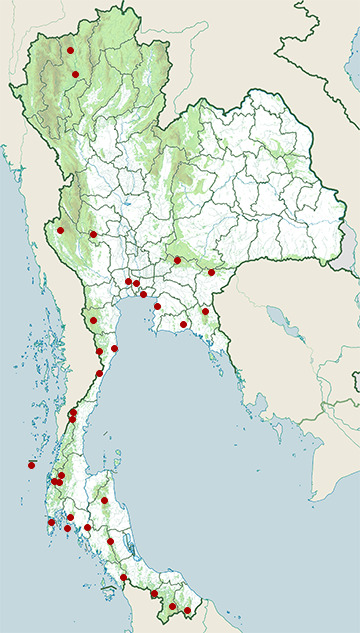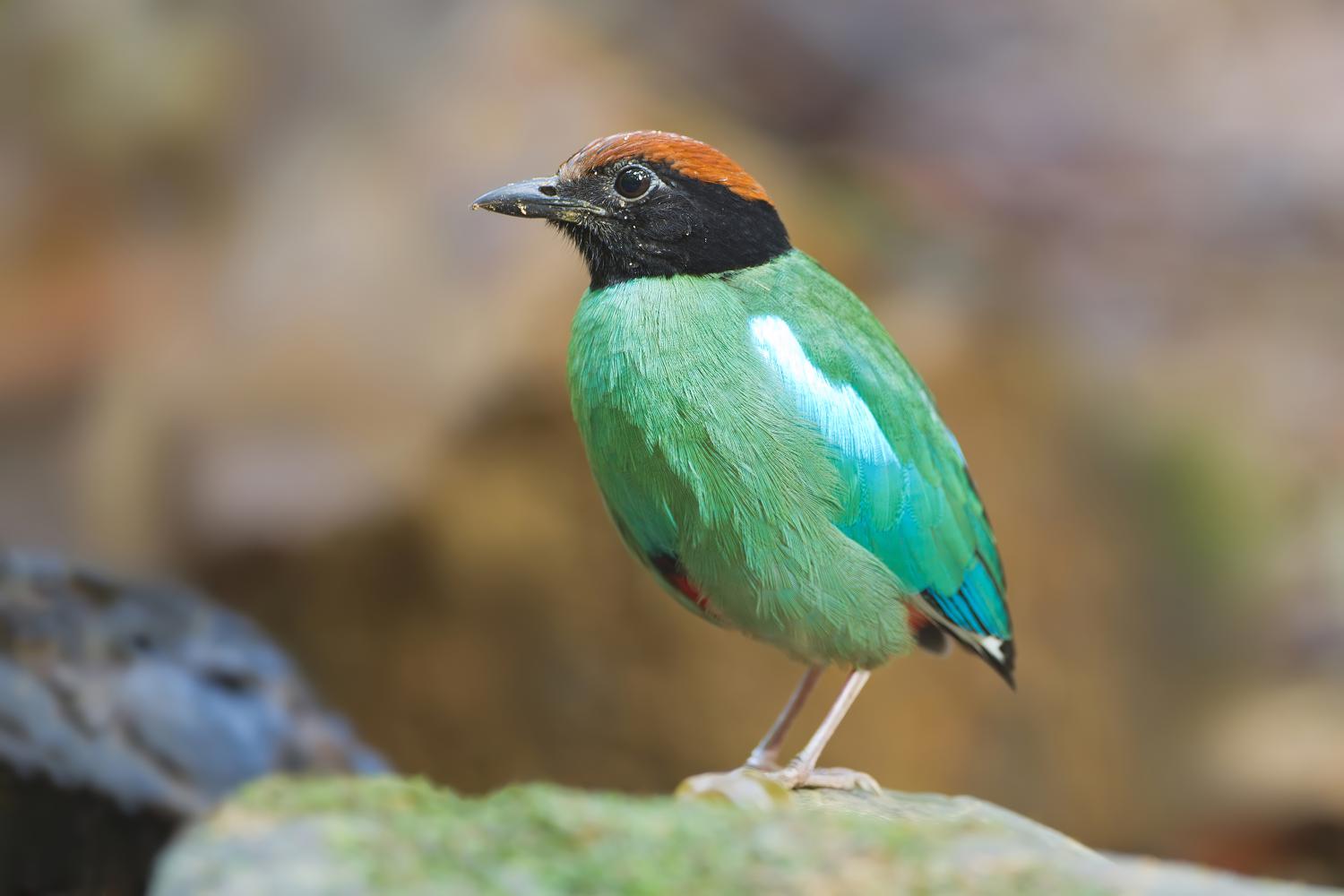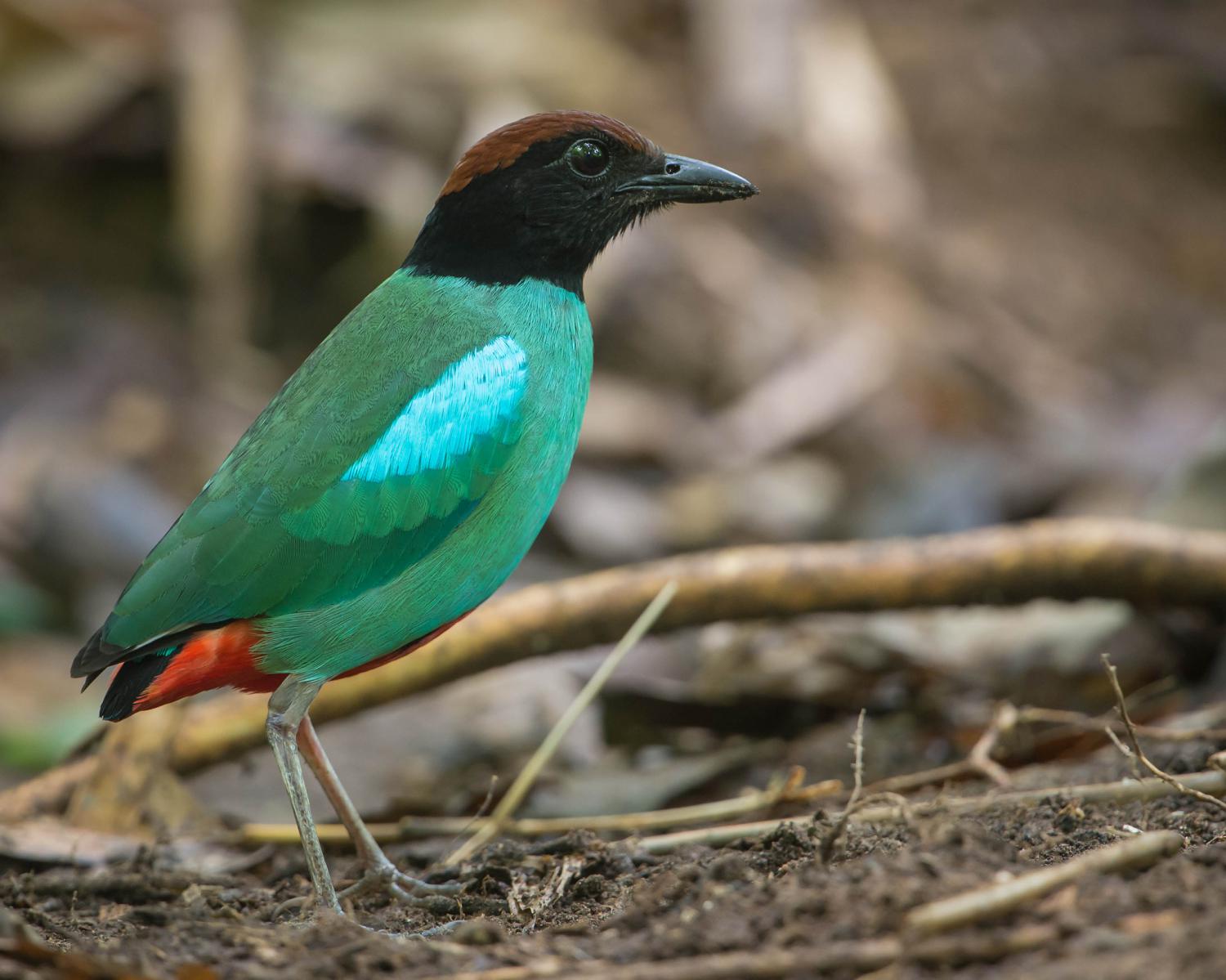Species of Thailand
Hooded pitta
Pitta sordida
Philipp Ludwig Statius Müller, 1776
In Thai: นกแต้วแล้วอกเขียว
The hooded pitta (Pitta sordida) is a passerine bird in the family Pittidae. It is common in eastern and southeastern Asia and maritime Southeast Asia, where it lives in several types of forests as well as on plantations and other cultivated areas. It is a green bird with a black head and chestnut crown. It forages on the ground for insects and their larvae, and also eats berries. It breeds between February and August, the pair being strongly territorial and building their nest on the ground. Incubation and care of the fledglings is done by both parents. The bird has a wide range, and the International Union for Conservation of Nature has assessed its conservation status as being of "least concern".
Taxonomy
The hooded pitta was described by the German zoologist Philipp Statius Müller in 1776 and given the binomial name Turdus sordidus. Statius Müller's description was based on a plate showing the "Merle des Philippines" published by Comte de Buffon in his Planches Enluminées D'Histoire Naturelle. The species is now placed in the genus Pitta that was erected by the French ornithologist Louis Jean Pierre Vieillot in 1816. The specific epithet sordida is Latin for "shabby" or "dirty".
Twelve subspecies are recognised:
- P. s. cucullata Hartlaub, 1843 – north India to south China and Indochina
- P. s. abbotti Richmond, 1902 – Nicobar Islands
- P. s. mulleri (Bonaparte, 1850) – Malay Peninsula, Sumatra, Java, Borneo and Sulu Archipelago
- P. s. bangkana Schlegel, 1863 – Bangka and Belitung Islands (east of Sumatra)
- P. s. sordida (Statius Müller, PL, 1776) – Philippines (except Palawan group)
- P. s. palawanensis Parkes, 1960 – Palawan Islands (west Philippines)
- P. s. sanghirana Schlegel, 1866 – Sangir Island (northeast of Sulawesi)
- P. s. forsteni (Bonaparte, 1850) – north Sulawesi
- P. s. goodfellowi White, C.M.N., 1937 – Aru Islands (off south New Guinea)
- P. s. mefoorana Schlegel, 1874 – island of Numfor (off northwest New Guinea)
- P. s. rosenbergii Schlegel, 1871 – island of Biak (off northwest New Guinea)
- P. s. novaeguineae Müller, S. & Schlegel, 1845 – west Papuan islands, New Guinea and Karkar Island (off north New Guinea)
Behaviour
Hooded pittas can reach a length of 16 to 19 cm and a weight of 42 to 70 g. It has a black head, chestnut crown and green body and wings. Its diet consists of various insects (including their larvae), which they hunt on the ground, and berries. In the breeding period, which lasts from February to August, they build nests on the ground; both parent take care of the eggs and the fledglings. They are highly territorial and their fluty double-noted whistle calls ("qweeek-qweeek") can be constantly heard from their territories, sometimes throughout the nights.
The International Union for Conservation of Nature is concerned in particular about the ongoing loss of habitat that this bird suffers, which is reducing its numbers, but has rated it as being a "least concern species" because the rate of population decline is insufficient to warrant a threatened category.
In captivity, hooded pittas mix well with other species although they may be aggressive toward other pittas when breeding. In London Zoo they are kept in a large walk-through aviary in the restored Blackburn Pavilion bird house, while at the Durrell Wildlife Park they are in a large walk-through exhibit with birds such as Palawan peacock-pheasants and white-rumped shamas.
This article uses material from Wikipedia released under the Creative Commons Attribution-Share-Alike Licence 3.0. Eventual photos shown in this page may or may not be from Wikipedia, please see the license details for photos in photo by-lines.
Category / Seasonal Status
BCST Category: Recorded in an apparently wild state within the last 50 years
BCST Seasonal statuses:
- Breeding visitor
- Mainly spring and autumn passage migrant
Scientific classification
- Kingdom
- Animalia
- Phylum
- Chordata
- Class
- Aves
- Order
- Passeriformes
- Family
- Pittidae
- Genus
- Pitta
- Species
- Pitta sordida
Common names
- Thai: นกแต้วแล้วอกเขียว
Conservation status

Least Concern (IUCN3.1)
Photos
Please help us review the bird photos if wrong ones are used. We can be reached via our contact us page.
Range Map

- Bang Lang National Park
- Bang Phra Non-Hunting Area
- Bang Pu Recreation Centre
- Bangkok Province
- Chiang Dao Wildlife Sanctuary
- Huai Yang Waterfall National Park
- Kaeng Krachan National Park
- Khao Banthat Wildlife Sanctuary
- Khao Laem National Park
- Khao Luang National Park
- Khao Phra - Bang Khram Wildlife Sanctuary
- Khao Phra Thaeo Wildlife Sanctuary
- Khao Sam Roi Yot National Park
- Khao Soi Dao Wildlife Sanctuary
- Khao Sok National Park
- Khao Yai National Park
- Khlong Saeng Wildlife Sanctuary
- Klaeng District, Rayong
- Kromluang Chumphon Wildlife Sanctuary
- Kui Buri National Park
- Mueang Chiang Mai District, Chiang Mai
- Mueang Krabi District, Krabi
- Pang Sida National Park
- Phi Phi Islands
- Phu Toei National Park
- Phutthamonthon District, Nakhon Pathom
- Sadeth Naikrom - Krom Luang Wildlife Sanctuary
- San Kala Khiri National Park
- Sri Phang Nga National Park
- Sukhirin District, Narathiwat
- Surin Islands
- Thale Ban National Park



